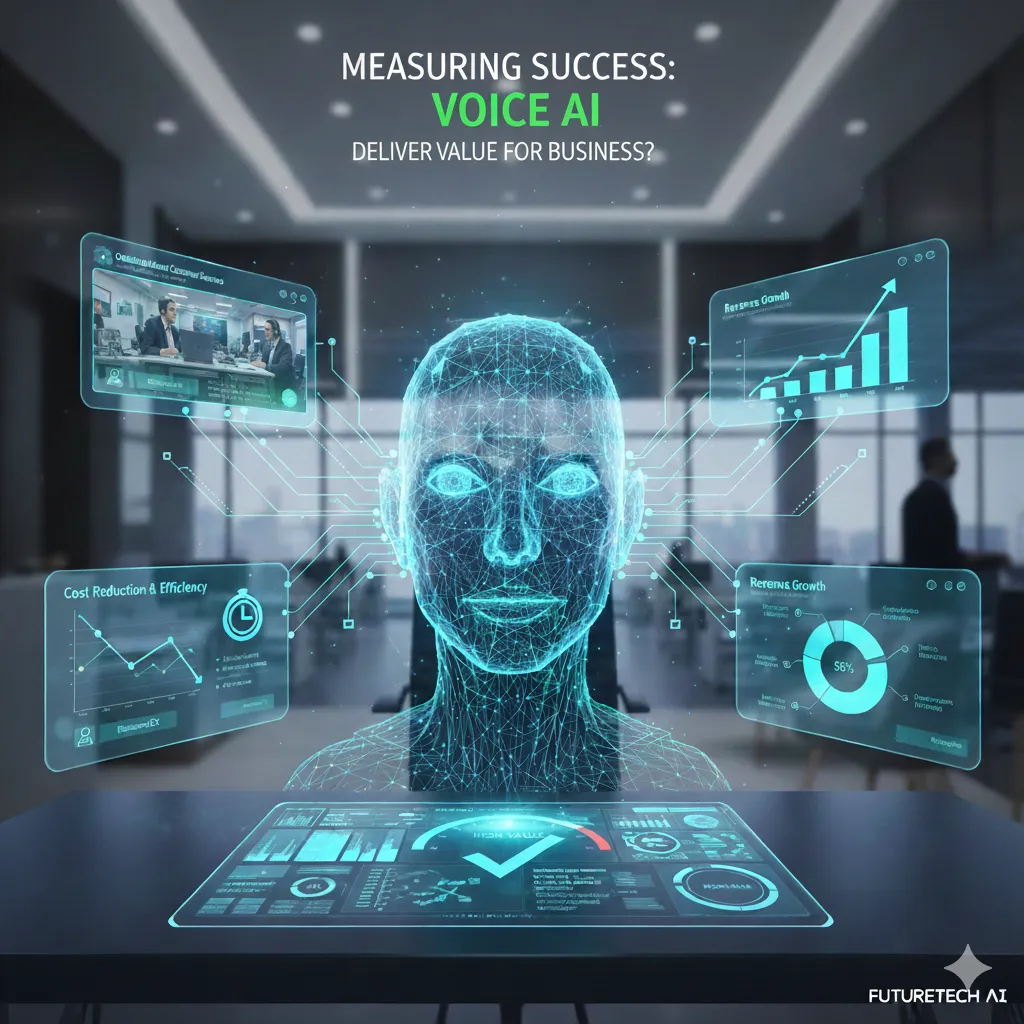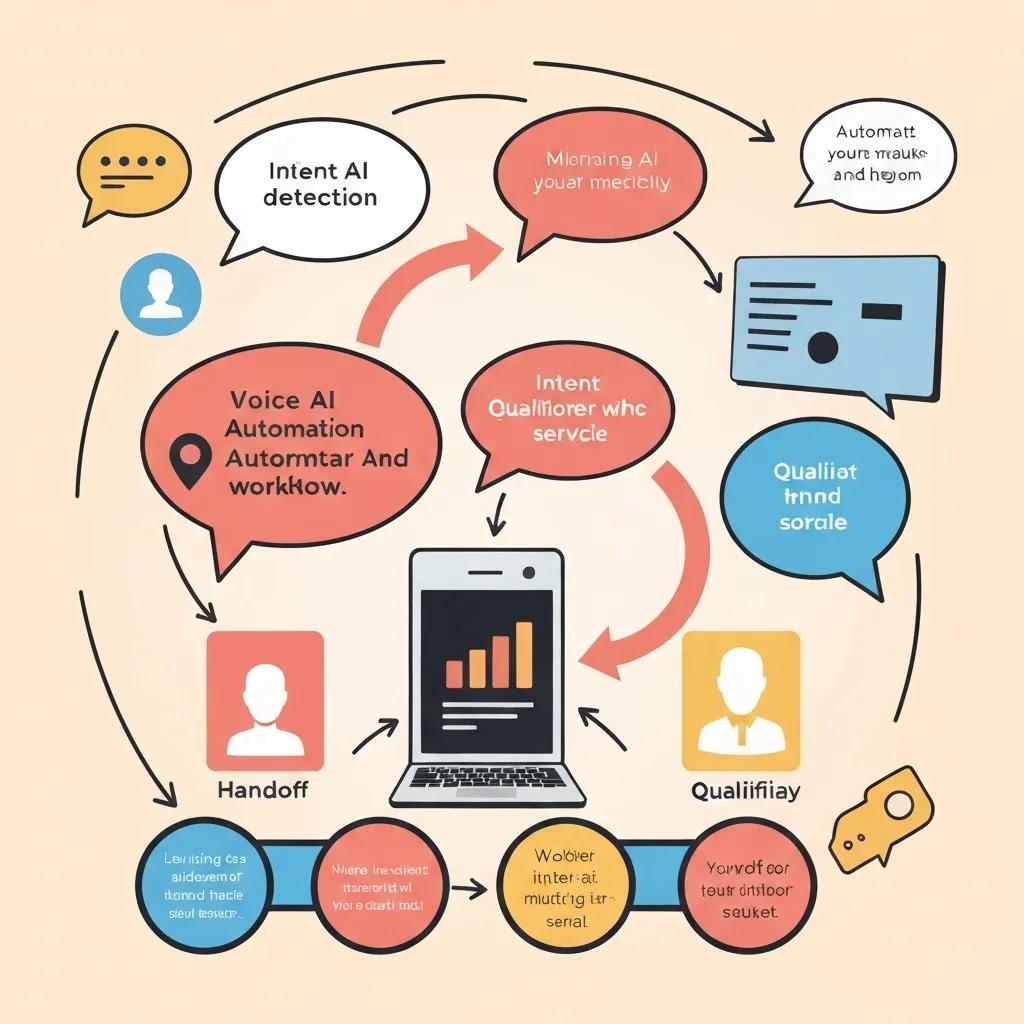
Measuring Success: Can Voice AI deliver value for business?

Voice AI combines automated speech recognition (ASR), natural language processing (NLP), and machine learning to convert spoken conversations into repeatable, trackable workflows that drive engagement and revenue. This guide outlines how voice automation captures missed opportunities, qualifies leads, and reduces operational cost while keeping a consistent customer experience across channels. Read on for clear benefit lists, actionable automation workflows for service and lead gen, industry-specific examples, and a practical roadmap for responsible implementation. We also explain how a coordinated multi-bot architecture: voice, lead-gen, chat, and operations amplifies results instead of treating voice as a standalone channel.
What Are the Core Benefits of Voice AI for Business Growth?
Voice AI gives customers continuous, conversational access by combining ASR and NLP to detect intent and trigger automated actions. The underlying flow, real-time speech-to-text, intent classification, and response orchestration delivers 24/7 availability, personalized interactions, and analytics that inform business decisions. Below are the primary benefits to evaluate when sizing voice AI for growth.
Voice AI delivers five core benefits:
24/7 Availability: Captures inbound demand and supports customers outside office hours so fewer opportunities slip through the cracks.
Improved Customer Experience: Natural dialogue and context carryover boost satisfaction and first-call resolution.
Cost and Efficiency Gains: Automation cuts repetitive work and average handle time, lowering operational cost.
Scalability: Systems handle increased traffic without proportional headcount or infrastructure growth.
Actionable Analytics: Conversational data surfaces trends that improve marketing, product, and ops decisions.
These benefits tie directly to the operational metrics teams use to justify voice AI—missed-call recovery, handle-time reduction, and lead-quality improvement. Knowing which outcomes matter most helps prioritize pilot use cases and KPIs.
The Power Labs’ AI Voice Bot reflects these strengths; around-the-clock availability, personalized conversational handling, multilingual support, and CRM-connected lead workflows so teams can quickly see improvements in lead capture and response times. To evaluate fit for your environment, contact The Power Labs for a demo of the AI Voice Bot and Four‑Bot System.
How Does Voice AI Enhance Customer Experience and Engagement?

Voice AI improves CX by enabling natural, context-aware conversations that detect intent and preserve continuity between interactions. ASR turns speech into structured text and NLP extracts intents and entities so systems can respond with relevant, personalized answers reducing friction for tasks like appointment scheduling or order tracking. When context follows the user across calls, repeat callers don’t have to re-explain issues, which feels faster and more responsive. Multilingual capabilities widen reach without adding specialized staff. Together, these features reduce unnecessary handoffs and escalate only complex cases to humans, protecting CX while lowering operational load and improving retention and conversions.
Research shows voice-based AI can improve call-center outcomes, increasing useful interaction time and lowering customer complaints on routine tasks.
Impact of Voice AI on Customer Service and Call Center Performance ABSTRACT: Voice-based AI systems are increasingly used to replace legacy interactive voice response in call centers. Using a natural field experiment in a large telecom call center, researchers examined how AI introduction affected call length, requests for human agents, and complaints. The study found AI increased call length while decreasing customer complaints for routine tasks, without significantly raising requests for human service. For simple service tasks, the AI-enhanced system reduced complaints among both experienced and inexperienced users.
In What Ways Does Voice AI Reduce Costs and Improve Operational Efficiency?
Voice AI lowers cost by automating high-volume, repetitive interactions reducing average handle time and the need for additional full-time agents as volume grows. It takes on routine queries (order status, basic troubleshooting, appointment booking), freeing staff to focus on complex, higher-value work. At scale, teams typically see a notable drop in cost-per-call and improved throughput during peaks. Deployments often enable redeployment of staff toward sales enablement and customer success rather than outright reductions. Measurable KPIs include shorter wait times, faster resolution, and better agent utilization together forming the business case for voice AI.
How Can Voice AI Automate Customer Service and Lead Generation?

Voice AI automates end-to-end interactions by detecting caller intent, qualifying needs through structured conversation, enriching lead records, and triggering downstream actions like CRM updates or human handoffs. The flow starts with ASR and NLP to interpret speech, then applies business rules and scoring to decide whether to route, convert, or escalate a contact. This increases capture of inbound demand, enables outbound campaigns, and preserves conversational context across channels. Below is a stepwise workflow showing how spoken interactions become qualified opportunities and operational tasks.
Typical voice AI workflow:
Intent Detection: ASR transcribes speech and NLP classifies the caller’s purpose.
Qualification: Structured questions gather contact details and intent signals for scoring.
Enrichment: Captured data is matched or appended to CRM records for sales use.
Handoff or Fulfillment: Qualified leads route to sales or are scheduled for follow-up; simple requests are completed automatically.
This sequence minimizes friction and ensures clean handoffs between automation and human teams so leads don’t fall through gaps.
In practice, The Power Labs’ AI Voice Bot serves as the frontline in a Four‑Bot AI System. The Voice Bot captures intent and hands qualified leads to an AI Lead Gen Bot or writes directly to CRM for sales follow-up. This coordinated approach prevents data silos, shortens time-to-contact, and keeps conversational context across voice and chat showing voice AI as part of a broader automation stack, not an isolated tool.
Combining AI, NLP, and reinforcement learning can sharpen sales automation by improving lead qualification and engagement through adaptive strategies.
Optimizing Sales Automation with AI, NLP, and RL ABSTRACT: This paper explores optimizing sales automation by integrating AI particularly NLP and reinforcement learning. It identifies friction in traditional sales processes (inefficient qualification and engagement) and shows how NLP improves intent understanding while RL adapts strategies to maximize conversions. The study tests a hybrid AI model within a sales automation tool on a diverse interaction dataset and reports improvements in qualification and conversion performance.
What Role Does Voice AI Play in 24/7 Customer Support and Sales Automation?
Voice AI provides always-on responses that capture inbound queries and run scheduled or event-driven outbound campaigns outside normal hours. Through conversational flows, voice bots answer FAQs, confirm appointments, and complete transactions so customers get timely responses across time zones. For sales, voice AI runs reminders, follow-ups, and re-engagement calls while keeping personalization through context-aware prompts. Complex or high-value cases escalate to humans with the full conversation history attached, reducing repeat questions and speeding resolution: building customer trust and accelerating pipeline velocity.
How Does Voice AI Improve Lead Qualification and Sales Conversion Rates?
Voice AI standardizes qualification with structured conversational scripts that capture intent signals, contact details, and contextual qualifiers for scoring or CRM tags. That consistency reduces variability in lead data and surfaces higher-quality prospects for sales. Enriched conversational insights: product interest, budget signals, timing help prioritize outreach and create more relevant sales conversations. As a result, leads that pass voice-bot qualification often convert at higher rates than raw inbound leads because handoffs include validated intent and context sales teams can act on immediately.
Which Industries Benefit Most from Implementing Voice AI Solutions?
Voice AI delivers the most value where high-volume, repeatable voice interactions map to measurable outcomes-healthcare, finance, e‑commerce, HR, marketing, and logistics stand out. Each sector has distinct pain points: appointment scheduling and triage in healthcare, secure routine inquiries in finance, order and return handling in e‑commerce, employee support in HR, campaign outreach in marketing, and delivery notifications in logistics.
How Is Voice AI Transforming Customer Support in Healthcare and Finance?
In healthcare, voice AI automates appointment scheduling and basic triage, easing administrative load while incorporating privacy and compliance safeguards. In finance, routine account queries and fraud alerts can be handled automatically and securely, freeing advisors for higher-value work. Across these sectors, voice AI shortens response cycles and raises throughput, but requires explicit data governance and compliance planning to protect sensitive information and maintain trust.
How can AI deliver real value to companies?
Retailers on the digital frontier rely on AI-powered robots to run their warehouses—and even to automatically order stock when inventory runs low. In e‑commerce, voice handles order updates, returns, and personalized offers that improve post-purchase satisfaction and reduce queue volume.
What Are the Unique Voice AI Applications in HR, Marketing, and Logistics?
HR uses voice automation for onboarding checklists, benefits Q&A, and internal helpdesk support to speed resolution and standardize employee experiences. Marketing deploys voice for conversational surveys, campaign follow-ups, and re-engagement calls that gather qualitative feedback and drive conversions. Logistics employs voice for delivery notifications, automated dispatch messages, and driver routing updates that raise on-time performance and reduce manual coordination. These applications show voice AI supports both customer journeys and internal operations with measurable impact.
How Does The Power Labs’ AI Voice Bot Work Within an Integrated AI System?
The Power Labs positions its AI Voice Bot as one part of a Four‑Bot AI System: an AI Lead Gen Bot, an AI Chat Bot, and an AI Smart Operations Bot work together to scale lead generation and streamline operations. The Voice Bot handles spoken entry points using ASR and NLP to interpret intent, then shares structured data and context with the Lead Gen Bot or CRM to enrich records and trigger next steps. This integrated setup keeps interactions consistent across voice and chat, synchronizes handoffs, and centralizes analytics to measure funnel performance and operational efficiency. The Power Labs highlights differentiators like 24/7 availability, consistent personalization, scalability, and Responsible AI practices in system design.
Component: AI Voice Bot
Role: Frontline voice interactions
Business Value: Captures leads, qualifies intent
Component: AI Lead Gen Bot
Role: Enrichment and scoring
Business Value: Improves lead quality and prioritization
Component: AI Chat Bot
Role: Persistent multi-channel engagement
Business Value: Nurtures leads across digital channels
Component: AI Smart Operations Bot
Role: Executes back-office tasks
Business Value: Automates fulfillment and routing
This table clarifies each bot’s responsibilities and how shared context lifts conversion and throughput.
What Are the Key Features of The Power Labs’ AI Voice Bot?
The Power Labs’ AI Voice Bot combines key capabilities: continuous 24/7 availability to reduce missed opportunities, NLU powered by ASR and NLP for natural conversations, multilingual support to widen coverage, and lead qualification that integrates with CRM and lead-gen tools. These features deliver practical benefits, instant responses, fewer misroutes, and enriched records for sales. Responsible AI principles guide design and deployment to ensure governance, transparency, and data security remain central.
How Does The Four-Bot AI System Enhance Business Automation Together?
When the four bots work together they form a pipeline: the Voice Bot captures intent and contact data, the Lead Gen Bot enriches and scores leads, the Chat Bot continues multichannel nurturing, and the Smart Operations Bot executes fulfillment like scheduling or dispatch. Shared context removes duplicate work, speeds responses, and increases conversions by preserving conversational continuity. This coordinated approach multiplies lead-generation potential over standalone voice deployments and supports scalable operations by distributing responsibilities among specialized agents.
What Are the Best Practices for Implementing Voice AI in Your Business?
Successful voice AI starts with clear objectives, mapped use cases, and measurable KPIs move from discovery to a focused pilot before scaling. Integration planning is critical: map CRM handoffs, escalation rules, and data flows to prevent friction between automation and human teams. Build Responsible AI and data security into the design: define consent, retention, encryption, and human-in-the-loop controls. Continuous monitoring, iterative model improvement, and alignment with business metrics keep the system accurate and valuable as volume and intent patterns evolve.
Key implementation checklist:
Define objectives and KPIs: Choose success metrics such as missed-call recovery, handle-time reduction, and conversion uplift.
Map integrations: Plan CRM, ticketing, and analytics connections and test handoff flows end-to-end.
Pilot with real traffic: Run a limited pilot, collect metrics and user feedback, then iterate before scaling.
What Are the Essential Steps to Plan and Integrate Voice AI Solutions?
Start with discovery to identify high-value use cases and stakeholder needs, then design conversational flows tied to outcomes and integration points. Evaluate vendors for technical fit, integration depth, and governance practices; run a pilot with real traffic to validate models and handoffs. During the pilot, monitor KPIs, gather qualitative feedback, and refine dialogs and scoring thresholds. Scale gradually while maintaining monitoring and retraining cycles to handle new intents and changing language.
How Can Businesses Ensure Responsible AI Use and Data Security in Voice Automation?
Responsible deployment requires policies and technical controls: minimize collected data and get explicit consent for recordings, encrypt data in transit and at rest, retain logs only as needed, and keep audit trails for decisions. Include human-in-the-loop checkpoints for ambiguous or high-risk interactions and give teams tools to review and correct model outputs. Monitor performance for bias, accuracy, and fairness, and document governance and compliance processes. The Power Labs embeds Responsible AI principles into product design rather than treating them as afterthoughts.
What Are Common Questions About Voice AI for Business?
Buyers typically ask about benefits, cost-effectiveness, timelines, and integration complexity. Voice AI delivers clear advantages: 24/7 availability, cost reductions, and better CX; but it requires upfront planning and integration to realize ROI. The FAQs below provide concise answers to help procurement, vendor, and operations teams prepare a targeted pilot and evaluate results against prioritized KPIs.
What Are the Top Benefits of Voice AI for Business?
Voice AI’s primary, measurable benefits are:
24/7 Availability: Captures leads and supports customers beyond business hours.
Cost and Time Savings: Automates routine interactions to lower handle time and operational cost.
Improved Customer Experience: Natural, context-aware conversations raise satisfaction and reduce friction.
Is Voice AI Cost-Effective for Small and Large Enterprises?
Voice AI can be cost-effective at any scale when assessed against the right KPIs and volumes. Small businesses gain from immediate 24/7 lead capture and fewer missed opportunities without hiring more staff; large enterprises benefit from volume efficiencies, centralized analytics, and standardized qualification that scale margins. The economic case balances upfront implementation effort against long-term reductions in cost-per-interaction and improved conversion rates—track metrics like missed-call reduction, handle-time drop, and uplift in qualified leads to demonstrate ROI.
This guide mapped core benefits, workflows, industry use cases, integration considerations, and governance practices to help you evaluate voice AI strategically. To see these capabilities in action and assess fit for your organization, contact The Power Labs to book a demo or consultation with our AI Voice Bot and Four‑Bot System team.
Frequently Asked Questions
What are the potential challenges of implementing Voice AI in a business?
Common challenges include integration with legacy systems, ensuring data security and compliance, and managing user expectations. Training the AI to handle diverse accents and dialects can affect performance, and some employees may worry about role changes. Mitigate risks with solid planning, thorough employee training, transparent change management, and continuous monitoring of AI accuracy and user feedback.
How can businesses measure the success of their Voice AI implementation?
Measure success with KPIs like reduction in average handle time, increase in lead conversion rates, and customer satisfaction scores. Establish baselines before deployment and track volume handled by AI, cost savings, and successful handoff rates to humans. Regularly review these metrics and pair them with qualitative feedback to refine the system.
What industries are seeing the fastest adoption of Voice AI technology?
Healthcare, finance, e‑commerce, and customer service are among the fastest adopters. Healthcare uses voice for scheduling and triage, finance for routine account servicing and alerts, e‑commerce for order status and returns, and customer service for high-volume inquiry handling. These sectors benefit from measurable efficiency and customer-experience gains.
What are the best practices for training Voice AI systems?
Train systems on diverse datasets that include different accents, dialects, and speech patterns. Update training data regularly to reflect changing language and customer needs. Use continuous learning and human review to correct errors, and run user testing exercises to gather feedback and iterate on dialogs and intents.
How does Voice AI ensure data privacy and security?
Privacy and security rely on encryption in transit and at rest, strict access controls, compliance with regulations like GDPR or HIPAA where applicable, and data-minimization practices. Obtain explicit consent before recording, maintain limited retention policies, and conduct regular audits and monitoring to surface vulnerabilities and preserve customer trust.
Can Voice AI be integrated with existing CRM systems?
Yes. Voice AI integrates with CRMs to capture and enrich interaction data, automatically update records, and surface qualified leads for sales. Effective integration requires planning, collaboration with IT, and testing of handoff flows so data stays synchronized and actionable.
Conclusion
Voice AI can materially improve operations—providing 24/7 coverage, enhancing customer experience, and reducing costs while enabling data-driven decisions that support growth. If you’re ready to explore how voice automation fits your priorities, reach out for a tailored consultation. See how voice can streamline interactions and accelerate outcomes for your business.